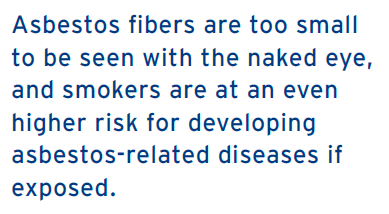Let’s look at the dangers of asbestos inhalation. Even though most uses of asbestos have been banned, it can still be found in a variety of products, such as building materials. Employees can be exposed to this hazardous material in residential and nonresidential buildings, and during renovations and demolitions of properties. The inhalation of asbestos fibers can cause serious damage to the lungs and other organs that may not appear until years after exposure. Asbestos fibers associated with these health risks are too small to be seen with the naked eye, and smokers are at a higher risk for developing asbestos-related diseases if exposed.
The Occupational Safety and Health Administration (OSHA) has standards to protect employees from exposure to asbestos in the workplace, as well as permissible exposure limits and exposure monitoring. OSHA regulations also exist for controlled zones and regulated areas that are designed to protect employees where certain work with asbestos is performed.
Avoid Asbestos Inhalation
The following tips are safety reminders for those who work near or with asbestos-containing materials:
• Never enter a controlled zone that the company has designated as a regulated area where asbestos work is being performed.
• If you are not wearing appropriate r espiratory protection, do not enter an asbestos regulated area.
espiratory protection, do not enter an asbestos regulated area.
• Do not eat, smoke, drink, chew gum or apply cosmetics in an asbestos regulated area.
• Read and obey all warning signs displayed in asbestos regulated areas.
• When working with asbestos, keep the material wet and vacuum the dust using a HEPA vacuum. Immediately collect and close all waste in bags designed to hold asbestos.
Protect Yourself from Asbestos Inhalation
• Always wear required protective clothing such as coveralls or similar full-body clothing, head coverings, gloves and foot coverings when working with asbestos. Face shields, goggles and other protective equipment are also necessary.
• Make sure you receive proper training and medical clearance if your work requires use of a respirator for asbestos protection. Use the correct type of respirator for the level of exposure. If you are present during the removal of asbestos, you must wear at least a half-face respirator with N-, R- or P-100 (HEPA) cartridges. OSHA also requires the use of a respirator in some cases when performing roofing and flooring work. Talk to your supervisor regarding whether you have sufficient protection.
• Follow all required hygiene and decontamination practices after working with asbestos.
• Leave your work clothes and shoes at work and wash them at work if they are not disposable. Family members of employees exposed to asbestos can get sick from asbestos taken home on an employee’s clothing or shoes. If required, shower at work after working with asbestos.
For More information on Protecting Yourself from Asbestos Inhalation
 Brian Blaston, Partner
Brian Blaston, Partner
Hardenbergh Insurance Group
phone: 856.489.9100 x 139
fax: 856.673.5955
email: brianb@hig.net


